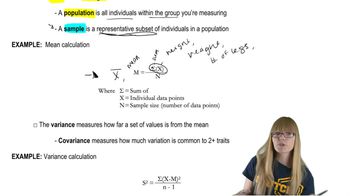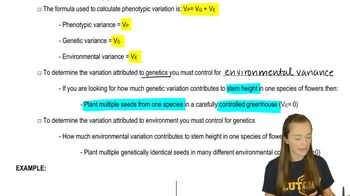Table of contents
- 1. Introduction to Genetics51m
- 2. Mendel's Laws of Inheritance3h 37m
- 3. Extensions to Mendelian Inheritance2h 41m
- 4. Genetic Mapping and Linkage2h 28m
- 5. Genetics of Bacteria and Viruses1h 21m
- 6. Chromosomal Variation1h 48m
- 7. DNA and Chromosome Structure56m
- 8. DNA Replication1h 10m
- 9. Mitosis and Meiosis1h 34m
- 10. Transcription1h 0m
- 11. Translation58m
- 12. Gene Regulation in Prokaryotes1h 19m
- 13. Gene Regulation in Eukaryotes44m
- 14. Genetic Control of Development44m
- 15. Genomes and Genomics1h 50m
- 16. Transposable Elements47m
- 17. Mutation, Repair, and Recombination1h 6m
- 18. Molecular Genetic Tools19m
- 19. Cancer Genetics29m
- 20. Quantitative Genetics1h 26m
- 21. Population Genetics50m
- 22. Evolutionary Genetics29m
3. Extensions to Mendelian Inheritance
Overview of interacting Genes
Problem 6
Textbook Question
Calculate the mean, variance, and standard deviation for a sample of turkeys weighed at 8 weeks of age that have the following weights in ounces:
161, 172, 155, 173, 149, 177, 156, 174, 158, 162, 171, 181.
 Verified step by step guidance
Verified step by step guidance1
Step 1: Calculate the mean (average) weight. Add all the weights together and divide by the total number of weights. Use the formula: , where is the sum of all weights and is the number of weights.
Step 2: Calculate the variance. First, find the squared difference between each weight and the mean. Then, sum these squared differences and divide by the total number of weights minus one (since this is a sample). Use the formula: .
Step 3: Calculate the standard deviation. Take the square root of the variance. Use the formula: .
Step 4: Verify your calculations by double-checking the sum of weights, the mean, and the squared differences to ensure accuracy.
Step 5: Interpret the results. The mean represents the average weight of the turkeys, the variance indicates the spread of the weights, and the standard deviation provides a measure of how much the weights deviate from the mean on average.
 Verified video answer for a similar problem:
Verified video answer for a similar problem:This video solution was recommended by our tutors as helpful for the problem above
Video duration:
1mPlay a video:
Was this helpful?
Key Concepts
Here are the essential concepts you must grasp in order to answer the question correctly.
Mean
The mean is the average value of a set of numbers, calculated by summing all the values and dividing by the total number of values. In this context, it represents the average weight of the turkeys at 8 weeks of age, providing a central value around which the weights are distributed.
Recommended video:
Guided course

Mathematical Measurements
Variance
Variance measures the degree of spread in a set of values, indicating how much the individual weights differ from the mean. It is calculated by averaging the squared differences between each weight and the mean, providing insight into the consistency of the weights among the turkeys.
Recommended video:
Guided course

Analyzing Trait Variance
Standard Deviation
Standard deviation is the square root of the variance and provides a measure of the average distance of each weight from the mean. It is a key statistic that helps to understand the variability of the weights, with a lower standard deviation indicating that the weights are closely clustered around the mean.
Recommended video:
Guided course

Mathematical Measurements

 7:56m
7:56mWatch next
Master Interacting Genes Overview with a bite sized video explanation from Kylia
Start learningRelated Videos
Related Practice
Textbook Question
Write a short essay that explains why multiple and lethal alleles often result in a modification of the classic Mendelian monohybrid and dihybrid ratios.
308
views
